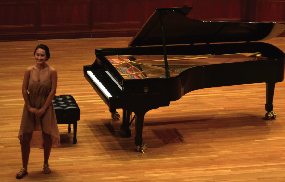
By Liz Dinsmore
Correspondent
Last Wednesday in Mayo Concert Hall, four student musicians performed in front of a full house of fellow students, family and faculty members who were eager to hear what the musicians had practiced so diligently to perfect.
The first musician played Johannes Brahms’s “Sonata No. 2 in E flat Major, Op. 120” on the clarinet and was accompanied by a staff musician on the piano. This composition is light and uplifting, lending itself beautifully to the clarinet.
Next out on stage was Doug Strahle, a senior music performance major, to perform Bach’s “Suite for Unaccompanied Cello No. 6.” This complex piece of music starts out strong and riveting and establishes a recognizable pattern of notes within just a few moments. These notes are then carried throughout the composition, sometimes in a very prominent motif, and other times as a respite from the fast-paced melody.
“It’s a rather difficult piece of the repertoire for cello, but I find a lot of enjoyment in practicing it and working out the challenges it brings,” Strahle said.
His performance of such a quick-moving piece was precise and clear, allowing each note to stand on its own, while simultaneously building upon the composition as a whole. Even with such a large audience, Strahle was able to play the cello gracefully.
“Performing for a large audience is definitely nerve-racking, but once you begin to play your instrument those nerves tend to drive you more than they inhibit your performance,” Strahle said.
The next performer played “Gliere’s Concerto in Bb, Op. 91” on the horn after a dramatic, yet inspiring opening on the piano. The occasional blast of the horn gave a feeling of strength to the song, but then a slower, more calm series of notes from the horn slowed the composition down and created a sense of depth that could not have been achieved otherwise.
The final performer of the afternoon was Meghan McEneany, a sophomore music education major, who played two very opposite compositions on the piano. The first piece was Sergei Rachmaninoff’s Prelude in G-sharp minor, Op. 32 No. 12. This dreamy and reflective composition is defined by the dichotomy of its bold beginning and romantic middle section, to create beauty out of its inherent complexity. The following piece, Chopin’s Etude, Op.10 No. 5, was uplifting, energetic, and animated because of its beat and speed of play. “My goal was to show a stark contrast in my program,” McEneany said. Each composition was able to evoke a different feeling from the audience: the first to dream and the second to awaken. When asked what it is like to perform for such a large crowd, McEneany said, “For me, performing is the most difficult part of being a musician, it also happens to be the most fulfilling and enriching. It can certainly be stressful performing in front of such a large audience, but once you are fully composed and are ready to lose yourself in the music, there is nothing like it.”
Freshman open options major Danielle McDermott responded to the recital by saying, “I wish I could play like that. I used to take piano and guitar lessons and watching them
These works covered any topics from over 60 different artists in order to engage the community and expand communication.
Emmons then went on to discuss a polling station workshop he created in which he had eight artists including himself design their own voting ballots containing any issues of their choice. The workshop had over 5,000 participants where people were able to vote on the issues presented on the ballots.
Emmons showed two voters’ responses on a ballot that introduced the issue of gay marriage. The first ballot read, “Let’s all be friends,” which resulted in an audible sigh of affection from the audience. The other read, “I’m a racist small minded pig, thanks for letting me vote,” which led to an uproar of laughter throughout the audience.
He closed by showing watercolor paintings of different types of polling situations around the world. Emmons said that he tries to take something familiar and recognizable and combine it with other ideas from different parts of the world.
“I try to put issues into different perspectives in order to get people to think about issues that they would otherwise ignore,” Emmons said.






